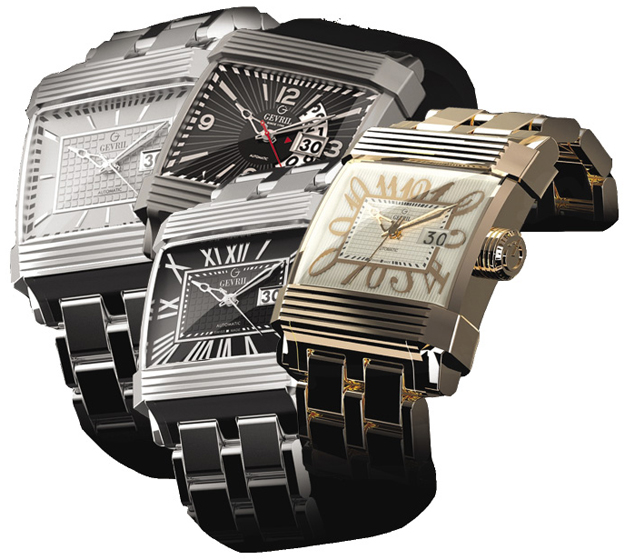- Home
- Media Kit
- Current Issue
- Past Issues
- Ad Specs-Submission
- Ad Print Settings
- Reprints (PDF)
- Photo Specifications (PDF)
- Contact Us

![]()
ONLINE

Full Service from Every Price Point
Editors’ Note
Samuel Friedmann began collecting and selling timepieces while in his teens. He transplanted his firm to America in 1990, and within 12 years, the global business was generating annual revenues of $25 million. In 2001, Friedmann purchased the historic Swiss timepiece company Gevril, realizing his early dream of owning a prestigious timepiece brand. Friedmann was born in Lugano, Switzerland.
Company Brief
Headquartered just outside metropolitan New York, Gevril (www.gevril.com; www.gevrilgroup.com) is a Swiss manufacturer of elegant, technologically innovative timepieces. Founded in 1743 by Jacques Gevril (who was appointed watchmaker to the Spanish crown in 1758, thus becoming the first exporter of Swiss watches) the pieces are handmade in Tramelan, Switzerland by Gevril Horlogerie. Each of the models – most of which are named for well-known Manhattan locations, including Chelsea, Gramercy, Madison, and SoHo – is limited to 100 numbered pieces in 18-karat gold and 500 in stainless steel.
How is Gevril positioned today in the watch market?
The Gevril Group is focused on being the watch vendor in the U.S. and the Caribbean for anyone that needs anything that has to do with watches. We are here to give them full service from every price point, shape and look, including after sale service.
The American market is different than other markets around the world. Customers in the American market like to buy in one place and have one contact for every need, and that is what we want to do and how we want to be of service.

The Gevril Times Square collection
Are you able to provide the same level of service no matter the price point?
Absolutely. We are 50 times the size we used to be three or four years ago and we have many more people, including brand managers for almost every brand, customer service, a repair department, an advertising department, a social media department, and a PR department – we are trying to cover every angle required by the business to give us a full swing.
In bringing new brands into the fold, what do you look for in determining whether or not a brand should be a part of the Gevril Group?
We evaluate the brand, the association to the brand, the collection, the price points, and the demand for it from around the world, as well as whether it has strong distribution around the world.
We want also to unveil many small or mid-sized brands that would not have a chance to succeed in the American market without our group. We give them an opportunity for growth and position them in the best way possible.
Are you working with retailer partnerships? How does the distribution work?
In the next three years, we plan to open over 50 stores under our umbrella, and right now, we’re working with around 250 point-of-sale stores.
We sell to luxury cruise ships, to retail stores, and to department stores. We are trying to service almost everyone that can sell watches because we want to be the address of choice. We also want to makes sure that we have every size and shape, from fashion to classic to sporty, and every price point. Then, if the industry changes because of the economy or demand, we’re still in business and we can help our retailers or our own stores survive any crises.
Have you been happy with how the Gevril brand has continued to evolve and how you have been able to bring new collections in?
We were worried at the end of 2008 and into 2009 because of the collapse of the economy, but we still had strong sales. We only dropped 10 percent in 2009; 2010 was flat; and for 2011, we’re looking for major growth in the brand.
With a number of brands under the umbrella, do you market those individually or as part of the group?
Every brand is marketed separately – that’s why we have separate brand managers.
The only thing we do under one roof is use the know-how, the connections, the public relations and advertising, and the after-sales and customer service.
Each brand has a different direction and a different price point, and each must be able to succeed on their own, not by piggybacking with other brands.
Is there coordination among North America and the Caribbean and other parts of the world, or do you treat them as totally separate markets?
The U.S. is a different market than the rest of the world, with a different approach and in many cases different styling, but there is a strategy. In the American market, the strategy of most of the retailers focuses on the next six months, but the strategy in the Far East or Europe is more long term – from two years to five or 10 years.
In Europe and the Far East, they are not as interested in what is happening now.
So you have to look at Europe and the States with totally different eyes and be prepared for the struggle.
When you’re engaged with so many brands, how can you provide the top after-service care?
It’s our first priority, because without that, we would not be in business.
For every brand, we give the same service – it doesn’t matter which brand it is.
But most of the problems we see is that people don’t know how to handle watches; it’s not the quality so much.
Do you worry about bringing in too many brands where you can’t have that individual focus?
Not really. We are growing step by step. This was a five-year plan that we started five years ago, and every day, we’re adding people in every department, and we’re looking forward to growing even stronger and bigger.•